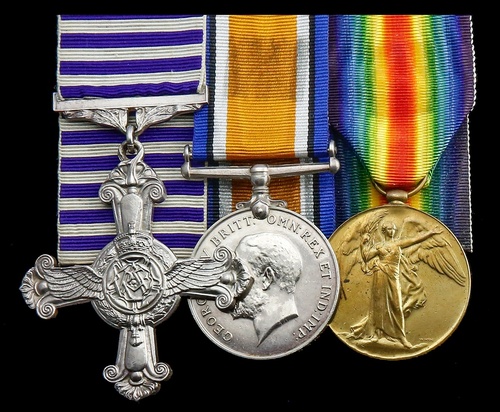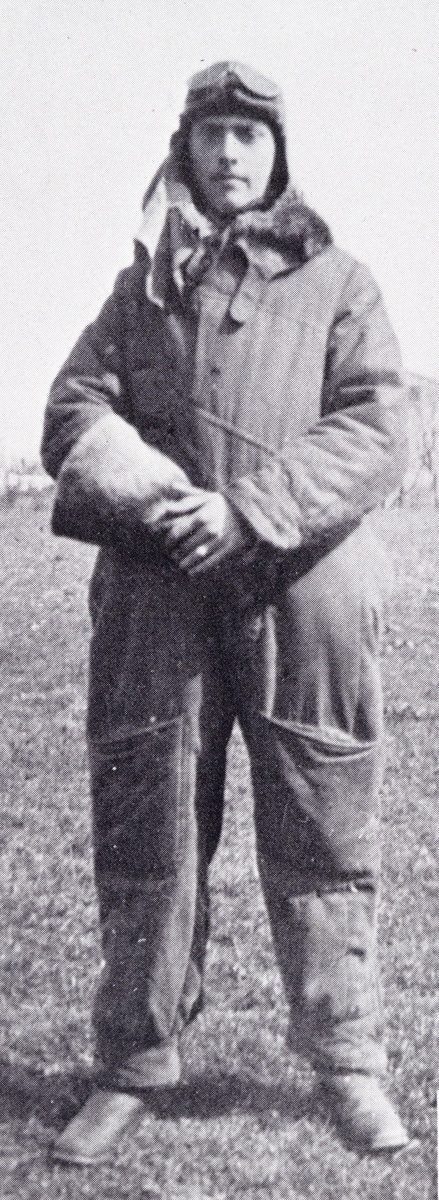Auction: 17003 - Orders, Decorations and Medals
Lot: 713
(x) The outstanding Great war fighter ace's Italy operations D.F.C. group of three awarded to Flight Lieutenant G. F. M. Apps, Royal Canadian Air Force, late Artists' Rifles, Royal Flying Corps and Royal Air Force
Commencing his operational career in Sopwith Camels of No. 66 Squadron in January 1918, he was to remain actively employed until being wounded by A.A. fire in his right leg in mid-July - a period encompassing in excess of 100 operational sorties and 10 confirmed victories
The same period also witnessed him going in to action alongside such legendary pilots as Captain W. G. Barker, V.C., D.S.O., M.C., and Lieutenant Alan Jerrard, V.C., and it was on the recommendation of the former that Apps joined the newly formed Royal Canadian Air Force: tragically he was killed in a flying accident in October 1931
Distinguished Flying Cross, G.V.R., the reverse privately engraved, 'Lieut. G. F. M. Apps, 24th July 1919'; British War and Victory Medals (Lieut. G. F. M. Apps, R.A.F.), a little polished, very fine or better (3)
D.F.C. London Gazette 21 September 1918:
'A bold and skilful airman who in recent operations has destroyed six enemy aeroplanes, accounting for two in one flight. He displays marked determination and devotion to duty.'
Gordon Frank Mason Apps was born in Lenham, Kent, in May 1899 and was educated at Sutton Valence School. He enlisted in the Artists' Rifles in February 1917, direct from an engineering apprenticeship at the Tilling-Stevens Motor and Munition Factory.
Transferring to the Royal Flying Corps that April, he qualified as a pilot and was commissioned 2nd Lieutenant. He was ordered to Italy and joined No. 66 Squadron, a Sopwith Camel unit, in which capacity he commenced his first offensive patrols in January 1918.
Fighter ace
Apps gained his first confirmed victory, a Berg Scout north of Valstagna, on 11 March, while flying with Alan Jerrard and Captain P. Carpenter, the latter stating that he last saw the Berg 'going down absolutely out of control, but was not seen to crash as it had disappeared, spinning slowly into a deep ravine, but would almost be certain to crash as apparently no machine could have landed safely in such a place.'
On 28 March, in a combat over the locality of Oderzo, Apps destroyed an Albatross D. III, the relevant report stating 'Lieutenant Apps followed his E.A. down to about 400 feet, firing about 300 rounds into the E.A., which crashed at 3.20 p.m. However, Apps's low-level tactics were not without cost, for 'machine-gun fire from the ground was very bad' and his 'machine was hit in several places.'
On 4 May, while patrolling over Vidor, Apps and three pilots of 66 were attacked by 14 enemy aircraft:
'Patrol then engaged these E.A. Lieutenant Apps got on the tail of a DV and shot him down in flames over the River Piave. The E.A. fell this side of the lines. Lieutenant Apps was then attacked head on by a D. III, this being repeated on four distinct occasions and on the last of which the E.A. went down out of control. This E.A. was observed to crash and the enemy pilot get out of his machine at Moriago by Lieutenant McLeod of No. 28 Squadron, who went down and shot the pilot.'
Once again Apps returned to base in a badly damaged aircraft: 'machine was shot through the engine, cowling, centre section, L.H. bottom plane, elevators and one flying wire shot away.'
In a combat on 20 May, fought alongside Barker and Lieutenant W. M. MacDonald, Apps chased down a D.V. which had been shot up by the former, thereby confirming his leader's victory - it crashed into the side of a mountain at Sevla.
A few days later, on the 24th, and once again flying with Barker, he claimed another confirmed D. III, following a spectacular 15 minute combat just above Mount Coppolo - 'Lieutenant Apps fired a long burst when the E.A. was doing a climbing turn and the E.A. went down out of control and crashed in the valley.'
On 21 June, during an offensive patrol with Barker over Motta, Apps took out a D.III, 'after a fight from 14,000 to 9,000 feet, during which he fired several good bursts, and the E.A. fell out of control and crashed just south of the railway at Sala di La. This was observed by Captain Barker.'
Having then destroyed another Albatross D. III in a combat over Chromenti on 28 June - it crashed near Cismon - Apps took out yet another in a combat at 5,000 feet south of Godega on 13 July, the latter, as confirmed by Barker, 'turning over and falling to pieces'.
Finally, on 16 July, Apps shared in the destruction of an L.V.G. south-west of Posimone with Lieutenant A. E. Baker, but on the following day he was seriously wounded in the right leg by A.A. fire and had to make an emergency landing back at base.
Evacuated for treatment in France, and thence in the U.K., he was passed as fit for home service duties in September 1918, when he joined No. 50 Squadron as a Flight Commander.
Post-war - R.C.A.F.
Finding employment as a civil engineer with the United Aircraft Company at Croydon after the War, Apps settled in Canada in the early 1920s, initially working for the G.P.O's Imperial Radio Chain. Of subsequent events, Norman Franks takes up the story in Fallen Eagles: Airmen Who Survived The Great War Only to Die in Peacetime:
'In the meantime, Apps applied to the Royal Canadian Air Force. He joined his old commander "Billy" Barker in the new air force on 19 March 1924. After a round of assignments to Winnipeg, Victoria Beach, Barrie, and Norway House, he was posted to an aerial survey project in 1926, tasked to photograph 25,000 square miles (65,000 km2) in the Red Lake District.
Apps married Norma Clairs Kennedy at R.C.A.F. Station, Winnipeg on 10 December 1927. Three years later, he was sent to R.A.F. Calshot, England for a technical course. He spent 15 December 1930 through 19 January 1931 on leave in England. The course ran from 20 January until April, and Apps took another leave post-course. His father Henry Apps died during this time; this may have given reason for some of the leave. By 28 May 1931, Gordon Apps had returned to R.C.A.F. duty at Camp Borden.
On 24 October 1931, Apps was flying Fairchild 71 serial no. 114 with Sergeant Frank Hand aboard. Apps fatally crashed while landing at Peterborough Airport. His burial, accompanied by a R.C.A..F military escort, was held in Winnipeg at the Chapel of Thompson Mortuary.'
Subject to 5% tax on Hammer Price in addition to 20% VAT on Buyer’s Premium. For more information please view Terms and Conditions for Buyers.
Sold for
£7,500







